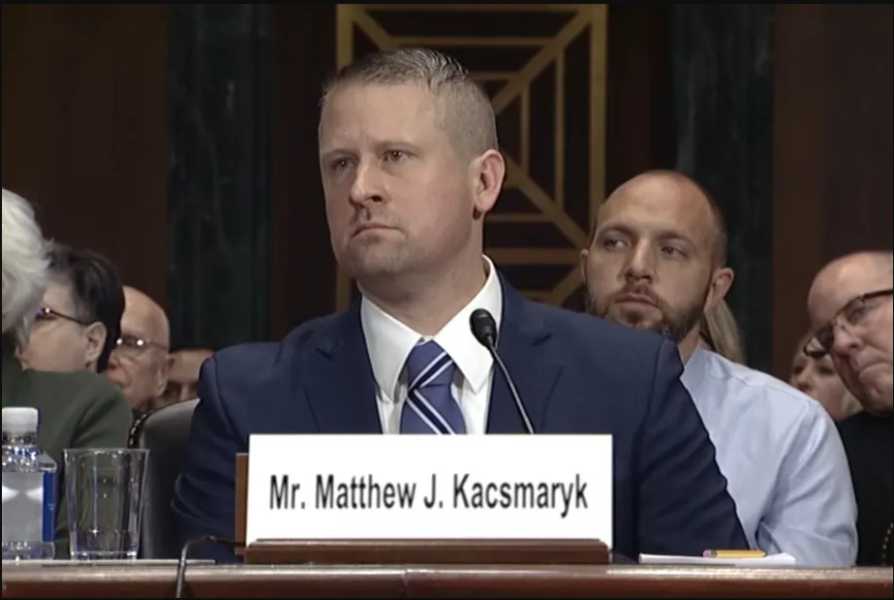Simmering tensions between traditionalist Republican judges and MAGA judges are starting to boil over.

Justices Brett Kavanaugh and Amy Coney Barrett talk before President Joe Biden delivers the State of the Union address to a joint session of Congress in the House Chamber at the US Capitol on February 7, 2023. Chip Somodevilla/Getty Images Ian Millhiser is a senior correspondent at Vox, where he focuses on the Supreme Court, the Constitution, and the decline of liberal democracy in the United States. He received a JD from Duke University and is the author of two books on the Supreme Court.
A federal court is picking an unusual fight with one of the federal judiciary’s governing bodies — one with implications for literally all aspects of US policy.
In March, the Judicial Conference of the United States, one of the federal courts’ internal governing bodies, announced a new policy intended to combat “judge-shopping.” Some federal courts effectively allow plaintiffs to choose their own judges, which has allowed many litigants with dubious or even ridiculous claims to obtain court orders blocking pretty much any federal policy that they find objectionable.
One court that allowed such judge-shopping, the United States District Court for the Northern District of Texas, announced on Friday that it will defy the Judicial Conference and refuse to implement the new policy. This defiance, if allowed to stand, would render the Judicial Conference’s new policy virtually useless, as the Northern District of Texas is the locus of the nation’s worst problem with judge-shopping.
Among other things, the fact that many right-wing plaintiffs can select Judge Matthew Kacsmaryk to hear their lawsuits has turned this obscure Trump appointee to this Texas federal court into one of the most powerful public officials in the country.
Kacsmaryk is a former lawyer at a Christian right law firm with a long record of hostility toward LGBTQ rights, abortion, and even many forms of heterosexual sexuality. He is the judge who attempted to ban the abortion medication mifepristone. And, in his brief period on the bench, he’s handed down a long line of orders implementing right-wing policies on birth control, immigration, and LGBTQ discrimination. He even backed a ban on theater performances he finds objectionable.

Now-Judge Matthew Kacsmaryk during his confirmation hearing. Courtesy of the Senate Judiciary Committee
The Northern District of Texas’s decision to defy the Judicial Conference sets up what could be a very significant conflict between this far-right court, and a broader federal judiciary that is controlled by more center-right judges — and it’s hardly the only such conflict brewing within the federal courts.
In its current term, the Supreme Court heard an unusually long list of cases arising out of the United States Court of Appeals for the Fifth Circuit, the MAGA movement’s most loyal stronghold within the judiciary. These include the mifepristone case, a case where the Fifth Circuit held that many domestic abusers have a right to own guns, a decision allowing Republican lawmakers to seize control of what content is published online, and a decision about the Consumer Financial Protection Bureau that, if upheld, could trigger a second Great Depression.
At least based on the oral arguments in those cases, however, it appears likely that an alliance between the Court’s three Democrats and its three least hardline Republicans will prevent the Fifth Circuit from reshaping the nation in MAGA’s image.
Similarly, it’s significant that, when the Judicial Conference announced its new policy against judge-shopping, it chose Chief Judge Jeffery Sutton as its spokesperson on this issue.
Sutton is a conservative George W. Bush appointee to the Sixth Circuit, and is an intellectual leader among more traditionalist Republican judges who believe in limited judicial power. By making Sutton the face of the new judge-shopping rules, the Judicial Conference seemed to signal that the federal courts’ non-MAGA Republicans shared many Democrats’ frustration with judges like Kacsmaryk.
It remains to be seen how the broader judiciary — and the Supreme Court in particular — will react to the Northern District of Texas’s insistence that anyone who wants to sabotage a Biden administration policy should be allowed to select Matthew Kacsmaryk as their judge. And, no matter how the broader judiciary reacts in the short term, lawyers like Kacsmaryk could easily find themselves in charge of the entire court system if former President Donald Trump has the opportunity to appoint more of him to the federal bench.
But, for the time being, there are significant signs that more traditionalist Republican judges are willing to ally with Democrats against the federal judiciary’s far right.
The judiciary is designed to be more resistant to political trends than the two elected branches
If you’re an elected Republican, publicly disagreeing with Donald Trump is a dangerous proposition. Some Republicans who cross Trump face literal death threats from MAGA voters, and even those who don’t are unlikely to prevail in their next primary election. As the Washington Post’s Josh Dawsey and Michael Scherer described Trump’s approach to the 2022 midterms, “he made it a near-singular mission to defeat GOP lawmakers who voted for his impeachment and who publicly disputed his claims of election fraud.”
The federal courts, by contrast, are designed to insulate judges from shifting political winds. Federal judges serve for life, and as a practical matter can only be removed against their will through impeachment. So they have no reason to take a stance that they personally disagree with out of fear that acting according to their own conscience will cost them their job.
Of course, the fact that judges serve for life does not mean that they are immune to far-right ideas. Many federal judges, including Kacsmaryk, already embraced a reactionary worldview when they joined the bench. Others have flexible ideologies that match whatever views are ascendant within the Republican Party at any given moment. Still others hope for a promotion and seek to catch the next Republican president’s eye by deliberately handing down extreme opinions. (Democratic judges sometimes engage in similar behavior, although they often have to temper their views because a GOP-controlled Supreme Court can reverse them if they push too hard.)
But the fact that judges have more freedom to break with their party than, say, members of Congress, means that the federal judiciary is currently a better reflection of the diversity of viewpoints within the GOP than, say, the US House of Representatives. Nearly every Republican member of the House is there because they survived a Republican primary, often after adjusting their public stances to ensure that they will not attract Trump’s ire.
The judiciary, by contrast, includes holdovers appointed during the Reagan and Bush administrations, as well as some Trump appointees who reject at least some of MAGA’s goals. That explains why Trump-appointed Justice Brett Kavanaugh has become one of the judiciary’s most vocal critics of Republican proposals to control who gets to speak online. It also explains why some of Trump’s attempts to overturn his loss in the 2020 presidential election were rejected by his own judicial appointees.
Republican judges still act like Republicans, even if they are not MAGA stalwarts
Of course, the fact that some Republican judges are more moderate than others does not mean that they are not Republicans. All six of the Supreme Court’s Republican appointees, for example, voted to end affirmative action at nearly all universities. All of them voted for a sweeping expansion of gun rights. All of them back novel legal doctrines which seek to dismantle much of the federal administrative state. All of the Republican justices except for Chief Justice John Roberts voted to overrule Roe v. Wade, and Roberts did not so much endorse Roe as suggest that his Court dismantle it more slowly.
What all of these issues share in common, however, is that the Republican Party long ago reached a consensus on them. Abortion foes, gun groups, and opponents of affirmative action have long been powerful voices within the GOP. And, while most Americans probably have no opinion on how the administrative state should function, the Federalist Society — the powerful conservative lawyers’ group which functions as the de facto legal arm of the Republican Party — has been obsessed with weakening federal agencies since the Obama administration.
There are plenty of issues, however, where the post-Trump Republican Party has broken with its pre-Trump consensus. And, on these issues, Republican judges are much more divided.
Consider, for example, free speech. Before Trump took over the GOP, there was a broad bipartisan consensus that even the most repugnant speech is protected by the Constitution. Thus, in United States v. Stevens (2010), the Supreme Court struck down a poorly drafted federal law banning “crush” videos, fetish videos that often depict a woman crushing an animal to death (Congress reenacted the ban in a differently worded statute that is less vulnerable to a First Amendment lawsuit). And, in Snyder v. Phelps (2011), the Court sided with members of a notorious church who protested a fallen marine’s funeral with signs featuring anti-gay slurs and the message “Thank God for Dead Soldiers.”
Both were 8-1 decisions, with only Justice Samuel Alito in dissent.
Indeed, before Trump ran for office, Republican judges generally took an even more expansive view of free speech than their Democratic colleagues. That’s because Republicans typically saw the First Amendment as a vehicle to dismantle campaign finance laws, while Democrats believed that the public interest in preventing political corruption overcomes the free speech arguments against such laws.
Much of the post-Trump GOP, by contrast, is eager to use the power of government to control political debates. The Republican legislatures of Texas and Florida, for example, both enacted laws seeking to seize control of content moderation at major social media outlets like Facebook, Twitter, and YouTube.
When the Texas law reached the Supreme Court in 2022, however, it cleaved the Republican justices down the middle. Roberts, Kavanaugh, and Justice Amy Coney Barrett all voted to suspend the law, while Justices Clarence Thomas, Alito, and Neil Gorsuch voted to let it take effect. Similarly, when the Court heard oral arguments last February to decide whether to permanently block these laws, Roberts, Kavanaugh, and Barrett all seemed to cling to the pre-Trump Republican position that the government should not regulate speech.
Similarly, while all six of the Court’s Republicans voted in New York State Rifle and Pistol Association v. Bruen (2022) to drastically expand gun rights, Roberts, Kavanaugh, and Barrett all appeared to recoil from Bruen’s implications once they realized it could arm domestic abusers who are subject to restraining orders. Kacsmaryk’s order attempting to ban mifepristone could have also forced the courts to remove thousands of medications from the market if it were upheld by higher courts — which may explain why only two justices, Thomas and Alito, dissented from the Court’s decision to block Kacsmaryk’s order last year.
So, while the Court’s Republican appointees tend to see eye-to-eye on issues that unite Republicans, they also divide on the sort of issues where there is no GOP consensus. And that means there’s a meaningful divide between the judiciary’s center right and its far right.
That said, this divide could stop mattering very quickly if Trump gets to fill additional seats on the Supreme Court. While lifetime appointments allow long-serving judges like Roberts or Sutton to drift away from their political parties, they do nothing to prevent a sitting president from appointing new judges who share that president’s views.
And so, if Trump wins, he could potentially fill the bench with Kacsmaryks — destroying the relevance of holdover Republicans with more moderate views, and tipping the debate in favor of the far right for good.
Sourse: vox.com